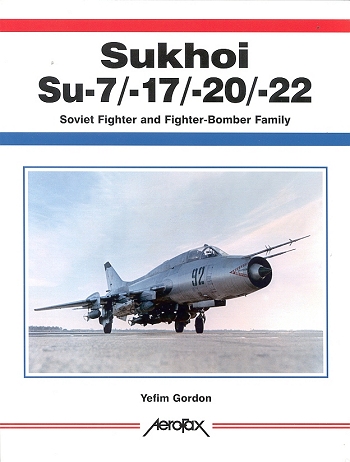 There has always been a fascination with the Sukhoi
'Fitter' family of aircraft amongst jet enthusiasts. Originally developed as an interceptor, the
Su-7 was turned into a fighter bomber early in its career. This was
as much due to the success of the Su-9 line of aircraft as with any
problems with the Su-7 itself. It is a bit difficult to find an equivalent
in the west as it was such a large and heavy aircraft, but I'm thinking
that perhaps the F-105 might not be an equivalent. It was fast, very fuel
thirsty and able to handle a lot of damage. That seems to fit both
aircraft.
There has always been a fascination with the Sukhoi
'Fitter' family of aircraft amongst jet enthusiasts. Originally developed as an interceptor, the
Su-7 was turned into a fighter bomber early in its career. This was
as much due to the success of the Su-9 line of aircraft as with any
problems with the Su-7 itself. It is a bit difficult to find an equivalent
in the west as it was such a large and heavy aircraft, but I'm thinking
that perhaps the F-105 might not be an equivalent. It was fast, very fuel
thirsty and able to handle a lot of damage. That seems to fit both
aircraft.
Unlike the F-105, however, the Su-7 was developed into the
variable-geometry (VG or 'swing wing), Su-17/20/22. The Su-17 and 20 were
basically the same airframe, but the -20 was somewhat downgraded in
equipment and designed for export. The final version of this aircraft was
the most capable Su-22, an aircraft that is still seeing some service,
despite the availability of more modern types. It is still a fuel hog and
still a most spectacular performer.
Yefim Gordon seems to be THE expert on Soviet types and
continues with his most prolific writings with this volume on the Su-7.
You'll find a lot of things that are similar amongst all the Aerofax books
over the last several years (not to be confused with the original Aerofax
series which was a lot smaller and had a lot more images).
It starts with a background into the development of the
aircraft. Then the design and testing of the Su-7 prototypes. Series
production of the original variant is next along with the number of
sub-types and prototypes. A section on the operational use of the Su-7
(which is quite considerable) is next, telling some really great 'there I
was' stories.
Then the book moves on to the development of the Su-17/20
swing wing aircraft. While most similar looking to the Su-7, there are many
differences, aside from the wings. For one thing, the Su-17 had to be
heavier to incorporate the additional stresses of the swing wing. What was
produced was an aircraft that was actually slower than the Su-7, but with
much improved landing and take off traits, making it actually easier to fly
than the older aircraft. The Su-17 was also developed in a number of
subtypes and eventually became the Su-22, an aircraft that was, again,
similar to the original Su-17, but in many ways very different and more
capable.
As with the Su-7, there is a section on the operational
history of the type, including its long-term use in the Soviet occupation
of Afghanistan, a situation that hits home with many Americans, though the
scale is different. There is a rather large section on Fitter operators
that includes as many serials and fates as can be determined. This is
followed by a section of drawings and finally, one that has several pages
of profiles.
There are a ton of photos in both b&w and in color to help
illustrate the book. Frankly, I doubt if you will find a more complete
history of the type and that alone makes it a book that is highly
recommended.
April 2005
Review book courtesy of
 ,
where you can order your copy of this and many other superb aviation and
modeling books. Visit their website at the link above or call them at
1-800-895-4585
,
where you can order your copy of this and many other superb aviation and
modeling books. Visit their website at the link above or call them at
1-800-895-4585
If you would like your product reviewed fairly and quickly by a
site that has around 300,000 visitors a month, please contact
me or see other details in the Note to
Contributors.
 There has always been a fascination with the Sukhoi
'Fitter' family of aircraft amongst jet enthusiasts. Originally developed as an interceptor, the
Su-7 was turned into a fighter bomber early in its career. This was
as much due to the success of the Su-9 line of aircraft as with any
problems with the Su-7 itself. It is a bit difficult to find an equivalent
in the west as it was such a large and heavy aircraft, but I'm thinking
that perhaps the F-105 might not be an equivalent. It was fast, very fuel
thirsty and able to handle a lot of damage. That seems to fit both
aircraft.
There has always been a fascination with the Sukhoi
'Fitter' family of aircraft amongst jet enthusiasts. Originally developed as an interceptor, the
Su-7 was turned into a fighter bomber early in its career. This was
as much due to the success of the Su-9 line of aircraft as with any
problems with the Su-7 itself. It is a bit difficult to find an equivalent
in the west as it was such a large and heavy aircraft, but I'm thinking
that perhaps the F-105 might not be an equivalent. It was fast, very fuel
thirsty and able to handle a lot of damage. That seems to fit both
aircraft.